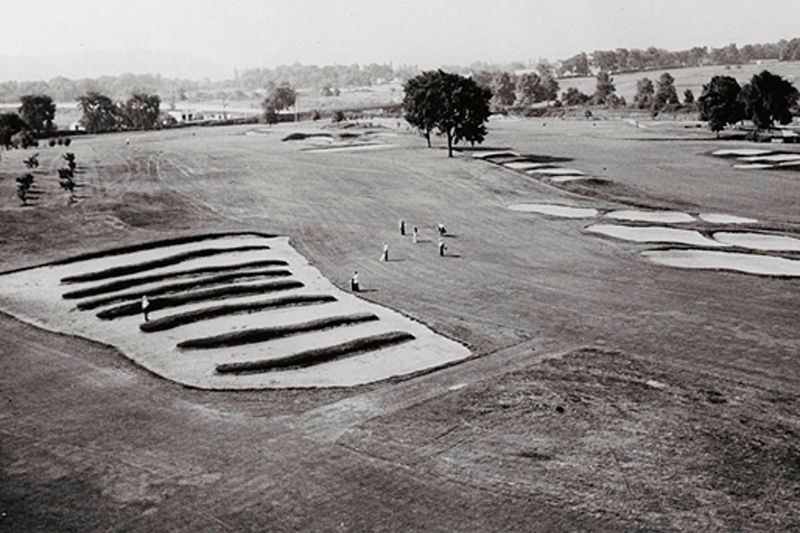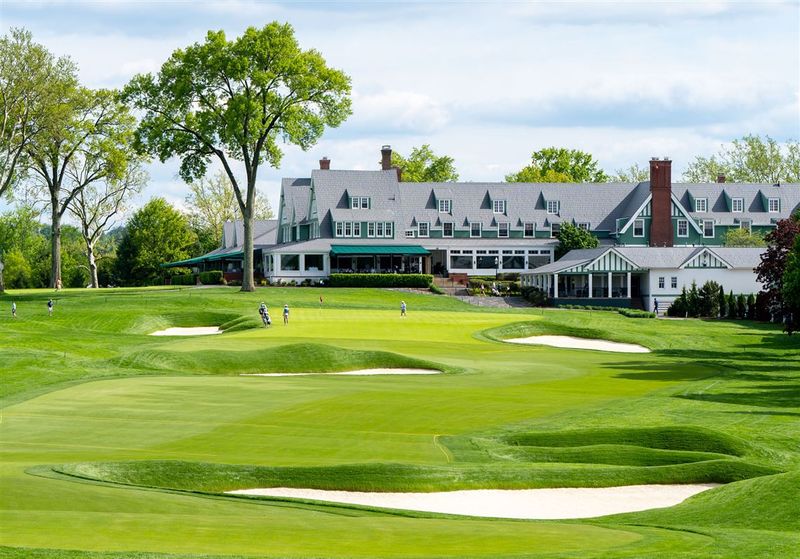Oakmont Country Club stands as America’s most feared golf course, where even professional players struggle to make par. Located near Pittsburgh, Pennsylvania, this legendary course has challenged golfers for over 120 years with its lightning-fast greens and punishing bunkers. Professional golfers often describe playing at Oakmont as the ultimate test of skill, patience, and mental toughness.
1. Record-Breaking U.S. Open Championship Host

No other golf course in America has hosted more U.S. Open championships than Oakmont’s impressive ten tournaments. The most recent championship took place in 2025, continuing a tradition that began in 1927.
Each tournament has produced memorable moments and challenged the world’s best golfers. The course’s reputation for difficulty makes winning a U.S. Open at Oakmont one of golf’s greatest achievements.
Golf fans consider Oakmont synonymous with the U.S. Open because of this remarkable hosting record.
2. Historic Par-80 Origins and Henry Fownes Design

When Oakmont opened in 1904, golfers faced an unusual par-80 layout featuring eight par-5 holes and one par-6. Henry Fownes designed the course with one goal: creating the most challenging golf test possible.
The original design included features that seemed impossible to play. Fownes believed golf should punish mistakes and reward only perfect shots.
Today’s par-70 layout still reflects Fownes’ philosophy of maximum difficulty. His vision transformed a simple game into an epic battle between golfer and course.
3. Famous Church Pew Bunkers

Oakmont’s most recognizable feature spans holes 3 and 4: the legendary Church Pew bunkers. These massive sand traps measure approximately 100 by 50 feet and contain 13 grass-covered ridges.
The ridges resemble church pews, giving this hazard its memorable name. Golfers who land in these bunkers often face impossible shots over the ridges.
Professional players consider the Church Pew bunkers among golf’s most intimidating hazards. Many tournaments have been won or lost in these distinctive sand traps.
4. Stimpmeter Invention Sparked by Oakmont Greens

During the 1935 U.S. Open at Oakmont, spectator Edward Stimpson Sr. watched Gene Sarazen putt completely off the green into a bunker. This incredible moment inspired Stimpson to invent the Stimpmeter, golf’s green speed measuring device.
The invention revolutionized golf course maintenance worldwide. Groundskeepers now use Stimpmeter readings to ensure consistent playing conditions.
Oakmont’s greens were so fast they literally created a new piece of golf equipment. The course continues setting speed records today.
5. Massive Tree Removal Project Restores Links Character

Oakmont removed over 14,000 trees since the 2007 U.S. Open to restore its original links-style appearance. Mid-20th century course changes had added numerous trees that blocked wind and changed playing conditions.
The tree removal project cost millions of dollars but dramatically improved the course. Wind now affects every shot, just as Henry Fownes originally intended.
Players notice the difference immediately when strong Pennsylvania winds sweep across the treeless landscape. The course now plays more like a traditional Scottish links.
6. Extreme Par-70 Layout with Monster Holes

Oakmont’s current par-70 design stretches 7,372 yards and features only two par-5 holes, both exceeding 600 yards. The 8th hole presents golfers with a 288-yard par-3, the longest in U.S. Open history.
These extreme distances challenge even professional golfers with perfect swings. Amateur players often need driver clubs for approach shots on par-4 holes.
The course design forces golfers to hit long, accurate shots consistently. Every hole demands maximum effort and perfect execution.
7. Lightning-Fast Greens Exceed Professional Standards

Oakmont’s greens consistently run between 14 and 15 on the Stimpmeter, speeds that terrify even professional golfers. Most golf courses maintain speeds around 9 to 11 for regular play.
Putts can roll completely off these greens if hit too hard. Golfers must develop touch and feel that borders on supernatural ability.
The maintenance crew works year-round to achieve these incredible speeds. Players often describe putting on Oakmont’s greens like rolling balls on marble floors.
8. No Water Hazards Challenge Traditional Golf Strategy

Unlike most championship courses, Oakmont contains zero water hazards, yet remains America’s most difficult golf test. The course proves that bunkers, rough, and green speed create more challenging conditions than water.
Golfers cannot rely on traditional water hazard strategies when planning shots. Every challenge comes from land-based obstacles that demand precision and power.
The absence of water makes Oakmont unique among major championship venues. Players face a pure test of golf skill without water penalty concerns.
9. Historic Golf Moments and Legendary Performances

Oakmont witnessed Johnny Miller’s legendary eight-under-par 63 in the 1973 U.S. Open final round, still considered one of golf’s greatest performances. Jack Nicklaus captured his first major championship here in 1962.
These historic moments occurred despite the course’s incredible difficulty. Miller’s round proved that perfect golf could conquer even Oakmont’s challenges.
Golf historians study these performances to understand how great players handle extreme pressure. The course has produced more memorable moments than almost any other venue.
10. National Historic Landmark Tudor Clubhouse

Oakmont’s magnificent Tudor-style clubhouse earned National Historic Landmark designation in 1987, recognizing its architectural and cultural significance. The building represents early 20th-century American golf club design at its finest.
The clubhouse has hosted presidents, celebrities, and golf legends throughout its history. Its elegant architecture matches the course’s reputation for excellence and tradition.
Members and visitors experience golf history when entering this remarkable building. The clubhouse serves as a museum of American golf culture and achievement.



